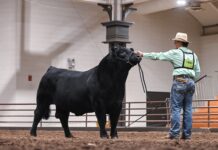SALEM, Ohio — Researchers are making progress in the fight against Johne’s disease. Scientists at Cornell University’s College of Veterinary Medicine recently developed a vaccine that prevents this contagious and often fatal bacterial infection.
Although it could take awhile for the product to be manufactured and approved for on-farm use, the breakthrough is noteworthy.
Disease facts
Johne’s disease is caused by a bacterium that is particularly hardy and can survive for a year in the outside environment. Related to leprosy and tuberculosis, the bacterium causes intestinal walls to thicken, which blocks the absorption of food. Infected animals will continue to eat normally, but since they cannot absorb nutrients, they begin to waste and eventually die.
Mainly infecting the small intestine, Johne’s disease is found around the world in ruminants such as dairy cattle, beef cattle, sheep, goats, deer, elk, llamas, alpaca, bison and certain wildlife.
Important
Yung-Fu Chang, Cornell professor of microbiology and the principal investigator of the vaccine research, said the new findings are important on several levels. Besides helping to control a disease that poses a huge threat to U.S. farmers, the results of this research could offer useful information about Crohn’s disease.
Crohn’s disease is an inflammatory illness affecting the digestive system in humans.
Cornell’s College of Veterinary Medicine is working with a private pharmacy company to develop the vaccine, although Chang declined to give the name. The antigen necessary for the vaccine development is licensed to the Biotechnology Research and Development Corporation.
There are no solid estimates on how long it could take to get the vaccine on the market or how much it will cost, according to the professor.
Control
Johne’s disease causes $220-250 million in losses every year in the U.S. dairy industry alone. Prevention has typically included culling infected animals and adjusting management methods.
The disease is hard to control because an infected animal sheds the bacteria in its manure, which means other animals in the herd or flock can become infected through contaminated feed or water. Infected cows can spread the disease to their unborn calves in utero and young animals can be infected through contaminated teats or infected milk from their mother.
Uninfected herds are often exposed to Johne’s disease when animals are brought in from other locations. Many times, infected animals do not show obvious, outward signs of the disease, but they still shed the bacteria in their manure.
Where we’re at
William Shulaw, a professor and Ohio State University Extension veterinarian for sheep and beef cattle, said Johne’s disease has attracted a lot of research recently, but it could still be years before a marketable vaccine is available.
He noted that a vaccine for Johne’s disease already exists in the U.S., but it comes with serious drawbacks. The current vaccine interferes with tuberculosis testing and humans can have very severe reactions if accidentally injected. Some states don’t allow the vaccine, although it is available in Ohio if a herd meets certain conditions.
The current vaccine does not completely prevent infection, but it does reduce the number of infected animals, prevent many animals from showing outward signs of infection and may reduce the amount of bacteria shed by infected animals.
Realistic
Shulaw is hopeful that there will eventually be a vaccination that offers the same, or better, protection against the disease without the risk to humans or interference with tuberculosis testing.
He is doubtful, though, that science will ever offer 100 percent protection against Johne’s through vaccine alone.
His reasoning is based on the fact that the organism that causes Johne’s is in the same family as the organism that causes tuberculosis. Human tuberculosis is currently the leading cause of death from infectious disease around the world because no highly effective vaccine exists.
While a new Johne’s vaccine would certainly offer some relief to farmers, Shulaw said it’s not a complete solution. Using a vaccine alone, without management changes, is unlikely to have a great effect.
Related article:
Free online course teaches Johne’s disease prevention









